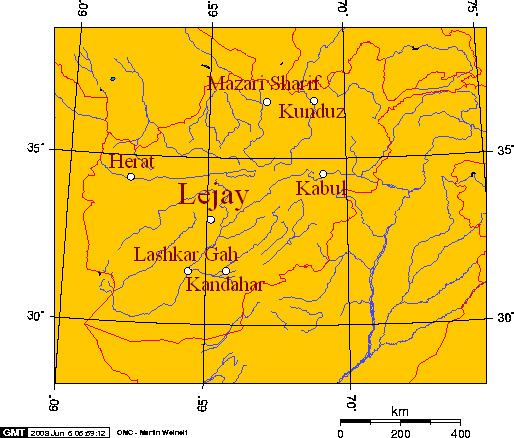Country Afghanistan Time zone UTC+4:30 | ||
 | ||
Weather 14°C, Wind S at 6 km/h, 63% Humidity | ||
Lejay, Afghanistan is a small village where a Taliban commander named Kabir (Sub-Cdr of Mullah Wahid - Objective), executed an ambush on a U.S. Special Forces Reconnaissance element, consisting of seven Green Beret detachments (A-Teams) on February 10, 2003. The killzone for the ambush site was 2 km wide by 3 km long. The subsequent battle, initiated by the ambush, lasted for 43 hours. During this engagement, a multitude of munitions were dropped by CAS (Close Air Support) ranging from 500 lbs to 2000 lbs.
Contents
- Press reports of the military action in the neighborhood of Lejay
- Inconsistent reports of the scale of the US operations
- References
Several of the Green Berets received shrapnel and grazing wounds, but none were medivaced from the area. At least 43 Taliban insurgents were killed during the engagement. As of February 2013, this remains the longest solely Green Beret battle of the Afghanistan conflict. The Green Berets who participated refer to this battle as the "Baghran Valley 3K Fun Run".
The Americans rounded up dozens of prisoners. By one account, the Americans rounded up 70 Afghans. Another account said they rounded up 40 Afghans. The Americans selected some of the men they rounded up;most of the men were released. They selected the men whose clothes appeared to have blood or gunpowder stains on them, or who were wearing army surplus jackets, or who appeared to have suffered temporary hearing impairment from firing weapons.
American soldiers questioned a large number of men of fighting age regarding the fighters who participated in the ambush and subsequent battle. The majority of those questioned were released and permitted to return to their homes. The Americans transported approximately 53 men of fighting age back to Bagram Air Field for further questioning. They detained these individuals because of additional circumstances, including to gun residue, 107mm grease, and various other indicators indicative of being a combatant. Military clothing or ownership of a weapon was not a factor, as this was and continues to be common amongst tribal entities throughout Afghanistan. They were mostly captured in the vicinity of the cave network, dubbed "Mickey Mouse Ears" where the American unit continued to take sporadic fire for eight days after the initial battle.
According to the evidence produced at the Combatant Status Review Tribunals, some of the men who were not released were sent to the Guantanamo Bay detainment camp, in Cuba.
Press reports of the military action in the neighborhood of Lejay
Coalition forces conducted an aerial campaign against the neighborhood of Lejay. Haji Pir Mohammad, the deputy governor of Helmand, led a six-man investigative team to the region, to investigate villager's reports of a massive American aerial bombardment. A Personal Security Detachment of 3 X A-teams, who accompanied the Karzai delegation. Mirwais Afghan (February 13, 2003). "Afghans Say More Civilians Die in U.S.-Led Raids". Reuters. Retrieved 2007-03-16. Pir Mohammad reported that he had seen 17 Afghan casualties, but he could not state whether the casualties were Afghan civilians, or enemy fighters, wearing civilian clothes. The delegation was in Lejay for two days (15-17FEB02). They were escorted by Green Berets as a security precaution. During the two days, only one casualty was identify which was a boy of approximately twelve years of age. It was not apparent what or who caused the injury.
Reuters interviewed Afghan official Haji Mohammad Wali, by phone, from Lashkargah, Helmand's capital. According to his account the civilian casualties were mainly women and children.
Reuters quoted a villager from the region who recounted seeing a home that had been demolished by the bombing, killing eight members of the family that had lived there.
Colonel Roger King, a US military spokesman, told reporters that the US Special Forces hunting the ambushers believed they were hunting between thirty and one hundred fighters. He informed reporters that American troops had found ammunition casings and empty rocket tubes. He called the reports of civilian casualties "unsupported". He stated that the US aerial bombardment had been confined to caves, and the ridgeline east and west of Lejay.
According to King:
"Battle damage assessment conducted in support of operation Eagle Fury has not indicated any non-combatant casualties to date,"
There was a single civilian casualty encountered in Lejay. Upon arrival of the Karzai delegation, 15FEB02, while my team and I escorted them to various surrounding villages, a boy who was approximately twelve years of age was brought out of a residence. The boy's uncle said that the boy had been shot by Americans. Our 18D (Medical Sergeant) was called forward and treated the boy's wound. It could not be ascertained who inflicted the injury. However, according to the uncle, the boy's father had taken him up into the mountains where they remained with others in an unidentified cave. The boy had been injured while collecting fire wood. The boy was MEDIVAC'd less than three hours later to Bagram Air Field for treatment. Between 10FEB02 and 18FEB02, there was a single funeral held IVO Lejay. The body of a Taliban fighter had been recovered from the cave complexes and, in accordance with the Muslim faith, was buried as soon as possible following death. That particular male had been killed by the concussion created from bombs which had been dropped IVO the cave he was in, due to the blood identified coming from his ears and nose. His body was also black from having been exposed to the harsh temperatures up in the mountains (There was a substantial amount of snow in the region at that time of year).
Inconsistent reports of the scale of the US operations
Press reports of the scale of the bombardment King reported were inconsistent.
